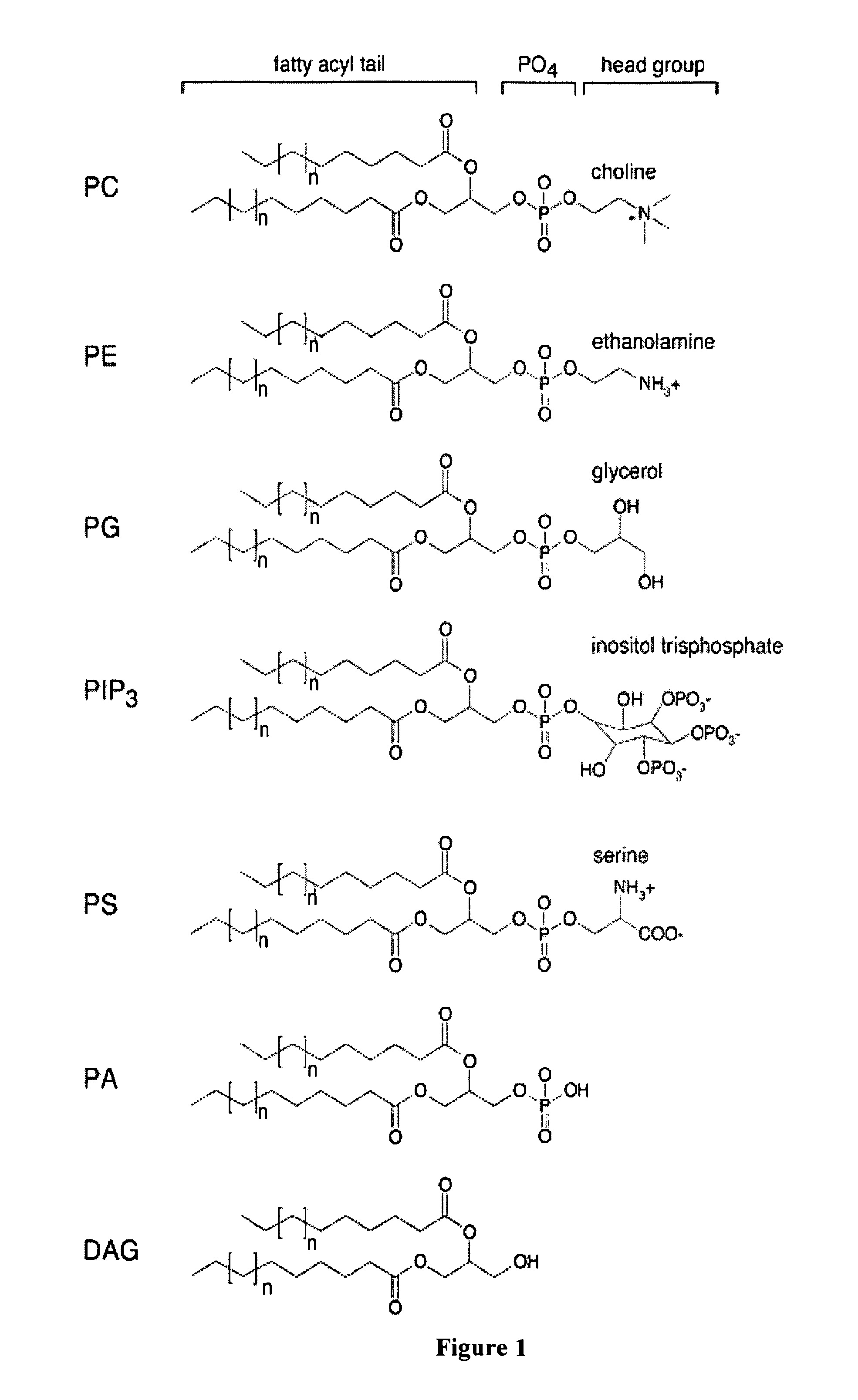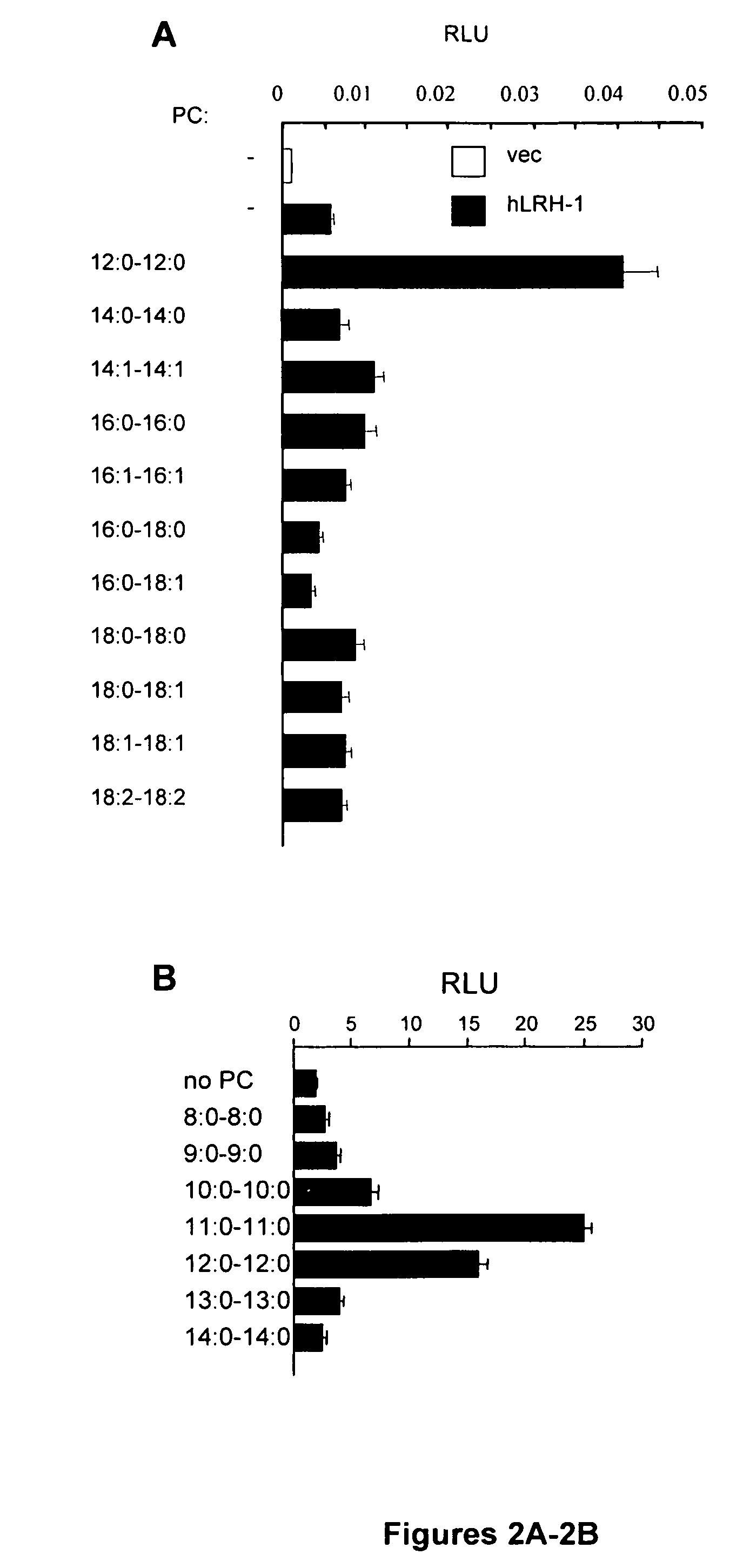Phospholipid compositions and uses thereof
a technology of phospholipids and compositions, applied in the field of phospholipid compositions, can solve problems such as the alteration of bile acid pools, and achieve the effect of improving insulin sensitivity and beneficial treatment effects
- Summary
- Abstract
- Description
- Claims
- Application Information
AI Technical Summary
Benefits of technology
Problems solved by technology
Method used
Image
Examples
example 1
Identification of LRH-1 Agonists
[0077]A number of different phosphatidylcholine (PC) species were screened for effects on human LRH-1 transactivation in HeLa cell cotransfections with a synthetic luciferase reporter containing multiple copies of an LRH-1 / SF-1 response element. Most had little or no effect on the basal LRH-1 transactivation, but a substantial increase was observed for the double C12:0 PC dilauroyl phosphatidylcholine (DLPC) (FIG. 2A). This was confirmed in more focused analysis of shorter saturated chain lengths. This analysis also showed responses to DLPC, as well as to 0-C11:0 diundecanoyl PC (DUPC) (FIG. 2B).
[0078]DUPC and DLPC induced similar, but lesser responses with this reporter in CV-1 and HEK293T cells, and also specifically increased LRH-1 transactivation of the native mouse SHP promoter by approximately 2-fold in HeLa cells (FIG. 3A). This is the same as the effect of the most potent synthetic LRH-1 agonist on the human SHP promoter (Whitby et al., J Med ...
example 2
Characterization of DUPC and DLPC as LRH-1 Ligands
[0084]We used both the mammalian two-hybrid assay and a standard GST pulldown approach to address the presumed function of DUPC and DLPC as LRH-1 ligands. The mammalian 2-hybrid analysis tested the interaction of a VP16-human LRH-1 ligand binding domain fusion with a second fusion of the Gal4 DNA binding domain to the receptor interaction domain of the coactivator SRC-3. As expected, this interaction was unaffected by chenodeoxycholic acid (CDCA) or DPPC, but was stimulated by DUPC and DLPC (FIG. 4A). In the GST pulldown, the substantial basal interaction of E. coli expressed GST-LRH1 with in vitro translated 35S-labeled full length SRC-3 was further increased by either DUPC or DLPC, but not by DPPC or 2 other conventional PCs (FIG. 4B). Quantitative measurements using PhosphorImager® imaging device of these and additional results showed that both DUPC and DLPC reproducibly increase SRC-3 binding by approximately 3-fold, while the ef...
example 3
In Vivo Effects of DUPC and DLPC
[0086]We used the simple route of oral gavage to deliver DUPC and DLPC to normal mice. As in the earlier experiments, CA served as a positive control for effects on bile acid synthetic genes and pool, and DPPC served as a negative control for effects on LRH-1. 8-week-old male mice received five treatments over a three day time course with vehicle (ethanol) or 100 mg / kg body weight of DPPC, DUPC, or DLPC. Compounds were administered in a PEG-400 and Tween-80 mixture (4:1), a cosolvent surfactant combination commonly used for oral delivery of hydrophobic nuclear receptor ligands (Mukherjee et al. Arterioscler Thromb Vasc Biol 18:272-6, 1998; Levin et al. Arterioscler Thromb Vasc Biol 25:135-42, 2005; Jung et al. J Lipid Res 48:2693-700, 2007). These treatments were not associated with any obvious toxicity, and did not alter liver weight or increase serum enzyme indicators of liver damage (ALT and AST). As expected, CA reduced expression of Cyp7A1 and Cy...
PUM
| Property | Measurement | Unit |
|---|---|---|
| length | aaaaa | aaaaa |
| enriched lipid composition | aaaaa | aaaaa |
| crystal structures | aaaaa | aaaaa |
Abstract
Description
Claims
Application Information
 Login to View More
Login to View More - R&D
- Intellectual Property
- Life Sciences
- Materials
- Tech Scout
- Unparalleled Data Quality
- Higher Quality Content
- 60% Fewer Hallucinations
Browse by: Latest US Patents, China's latest patents, Technical Efficacy Thesaurus, Application Domain, Technology Topic, Popular Technical Reports.
© 2025 PatSnap. All rights reserved.Legal|Privacy policy|Modern Slavery Act Transparency Statement|Sitemap|About US| Contact US: help@patsnap.com



